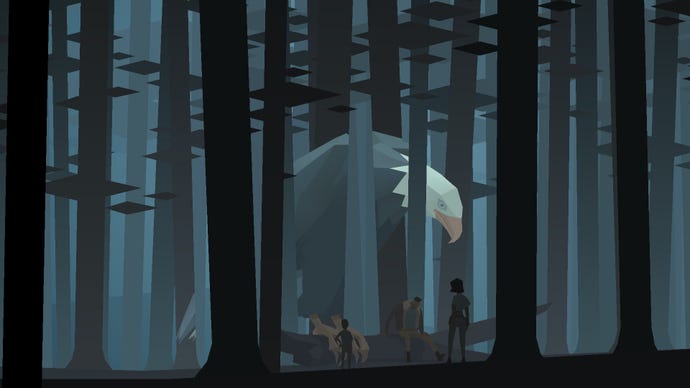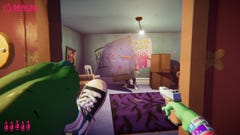RPS GOTY Revisited: 2013's Kentucky Route Zero goes nowhere fast, and that's why we love it
Truck Driving Simulator '13
When RPS awarded Kentucky Route Zero the title of Game Of The Year in 2013, only two episodes out of an eventual five had been released. If this sounds like a bland statement of fact, just think about it for a second. I can't recall any other time an episodic adventure game has received GOTY-level praise before it was even concluded, let alone only 40% done.
Episodes three through five arrived sporadically: in spring 2014, summer 2016, and — after what must have been an agonising hiatus — the start of 2020. Having bypassed this wait to play the game for the first time only recently, I feel wistfully as though I'll never share quite the same fond feelings for it as contemporary fans (like our own reviews ranger Rachel, who recently named KRZ one of her all-time favourite indie games). But I'm also quite relieved that I didn't have to exercise that kind of patience. I mean, I'm very good at neglecting to carry on with games for years at a time despite thoroughly enjoying what I've played so far. But I like doing it on my terms, you know?
I initially attempted to do something a bit clever with this retrospective. I wanted to play the first two episodes that earned KRZ our GOTY nod in 2013, and write up on them as a discrete entity as far as possible. Only then did I plan to carry on the game and add some follow-up impressions, perhaps assessing whether I thought RPS would still award the big chocolate medal to the full game as it finally came to be in 2020. But, after sitting with my feelings about Episodes 1-2 for a couple of weeks, any intelligent observations I might have made were drowned out by an increasingly loud, insistent voice in the back of my head howling: "I WANT TO KNOW WHAT HAPPENS." Actually, that might be a good impression to just let stand on its own merits.
It's an interesting reaction to have, because Kentucky Route Zero is at once highly plot-driven, and not really at all about advancing through a story. On the one hand, it's one of the most classic hero's journey narratives I've played in a while, with a protagonist who is both literally and metaphorically driven (ba-dum-tish) to reach his destination against increasingly improbable odds. But if ever there was a point-and-click game that wanted you to slow down and soak in the atmosphere, it's Kentucky Route Zero.

Kentucky Route Zero is a point-and-click adventure game firmly of the 2010s school, which means that those of us who fondly remember the genre's golden age in the 1990s can feel jarred by what could initially be mistaken for a lack of interactivity. Sierra raised me well to be the sort of player who wants to spend 20 minutes trying out eight different interactions on every single part of the screen, just for the pleasure of hearing Tim Curry drawl out his commentary. In KRZ, as in most modern adventure games, interaction is limited to a tiny handful of important hotspots per scene.
However, the opening minutes of Kentucky Route Zero's first episode do an incredibly elegant job of demonstrating what you get to do instead of taking a guided tour. Almost every spoken interaction in the game comes with multiple dialogue choices, allowing you to very quickly develop and reinforce your sense of main protagonist Conway and his character. A few of these choices have consequences, including the very first one in the game, which allows you to choose whether your elderly canine companion is a male dog named Homer, a female dog named Blue, or a nameless stray. It's a minor decision in the grand scheme of things, but one that will subtly permanently alter your experience for that playthrough.

Most choices in this game, however, don't directly affect anything. But they're the opposite of unimportant. I once heard it said that modern narrative adventure games prefer to judge you on your attitude towards making decisions rather than the decisions themselves, and KRZ definitely has overtones of that. But the most important thing is how your dialogue choices shape the narrative in your mind, something that the game itself can't measure for you.
For example: is Conway laconic or chatty? Terse with strangers or open and friendly? More inclined to crack a joke and move on or curiously pursue an intriguing statement? Or any of the above, depending on the situation? The array of options is always there, with nothing locked off even if your earlier choices render them technically untrue. Within a very short while I had a strong sense of who I thought Conway was, and almost always found a way to play him accordingly.

Looking back over the 2013 RPS Advent Calendar, it's apparent that weird and/or moody environmental exploration games were all the rage a decade ago — which is absolutely 100% fine by me, long live the walking sim as far as I'm concerned. The melancholy and occasionally spooky Gone Home took our runner-up spot that year, with The Stanley Parable in fifth place representing a very different kind of surreal take on the genre compared to KRZ.
Kentucky Route Zero is, of course, melancholy and spooky and surreal and weird and moody and also has really great music, so it taking pride of place makes sheer mathematical sense, even if I still feel like giving a GOTY badge to a less-than-half-finished game is unusual and probably shouldn't happen too often. But I'm glad that Kentucky Route Zero got to be an exception. Of course, I have the benefit of knowing something the RPS staffers of yore didn't, namely: what happens next. And oh, there's some good stuff still to come, past denizens of the treehouse. I hope you managed to keep up.


















